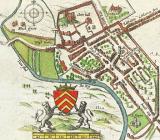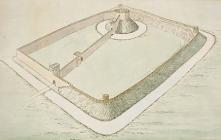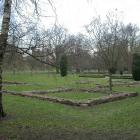Medieval Cardiff
Items in this story:
Capital city of Wales
Travelling around Cardiff, capital city of Wales, it is easy to forget that this modern city's origins were laid many centuries ago. The heart of the city was formed during the medieval period and many traces from this time survive today, especially close to the castle.
Cardiff lies at the centre of three river systems, the Taff, the Ely and the Rhymney. Its location allowed its first residents to control trade and movement along these rivers, giving them power over a large area.
Roman Cardiff
The first people to take advantage of this location were the Romans who set up a fort here about AD55-60. This dominating fort protected its inhabitants until about AD350-375 when it was abandoned at the end of Roman rule in Britain.
The stone walls of the fort provided later generations with a massive source of building materials, while a further legacy from the Romans was a network of roads linking Cardiff with neighbouring areas.
The medieval castle
Today, much of Cardiff's Roman remains are lost beneath the medieval castle. The castle dates from the 11th century, when the Normans conquered Glamorgan. It was begun by William the Conqueror on his return from St David's in Pembrokeshire, in 1081. This is supported by an inscription on a coin found within the castle grounds which suggests that William may have established a mint at the castle.
Cardiff Castle was originally built in wood. In the 12th century, Robert Consol, Duke of Gloucester, rebuilt it in stone. At this time, the Castle's west and south walls were raised, building upon the ruined walls of the Roman fort.
Owain Glyndŵr
In the 15th century, the castle, town and suburbs were destroyed by Owain Glyndŵr's Welsh army. The Castle lay in ruin until Richard Beauchamp, Earl of Warwick, restored the defences and castle buildings in 1423. Beauchamp also constructed the octagonal tower, now known as Beauchamp's tower.
Much of the rest of the castle and walls dates to the 19th century, when the third Marquis of Bute employed William Burges to restore, refurbish and rebuild it.
The medieval town
Cardiff's Shire Hall was built inside the castle's walls in the 15th-century. It was in use as the town's administrative centre until the 17th century.
The medieval town spread out from the castle's South Gate. Interestingly the High Street lines up with the Roman rather than the medieval south gate, suggesting it dates from this earlier period.
The Medieval town probably developed in two stages. The first stage was within a relatively small enclosure marked out by Working Street and Womanby (Hummanbye) Streets' both names are linked to old Norse. In the second stage of its development, Cardiff expanded south. The town was then enclosed and defended to the east by a bank and ditch and eventually a stone gate. To the west, the town was protected by the meandering river Taff.
The river Taf had a big influence on the shape of medieval Cardiff. Until the 1840s, the river flowed slowly towards the south, from the direction of the castle walls. By 1610 the river had reached Hummanbye Street, and was beginning to disturb St Mary's Church. By the beginning of the 19th century, the church had been completely destroyed, and today only the name remains as a street name.
Only two parts of the medieval walls remain, both to the east of the castle walls. The first contais a flower bed near the Roman fort's wall, while the larger part is across the road behind the shops. Most of the old walls' foundations were destroyed by the enormous shopping centres which swallowed so many of the city's narrow medieval streets.
Cardiff's first suburb was built outside the East Gate, Cokkerton Street, Queen Street today (though there is a narrow lane called Crockherbtown Lane behind Queen Street). The name suggests that poters ('crockers') worked in the area. It made sense to keep industry out of the main part of town as kilns and wooden buildings do not co-exist well!
Remains of the medieval wall
Only two sections of the medieval wall are known to survive. The first supports a flower bed just east of the Roman fort wall, while the larger surviving piece is across the road behind retail outlets. Much of the surviving foundations of the wall were destroyed by the large shopping centres which swallowed up many of the small medieval alleyways of the city.
Remains of the castle wall
The lower section of the castle wall belonged to the Roman fort, while the upper section was added in the 1920s. During the medieval period, building plots were packed so tight against the Roman wall, that some of the inhabitants were forced to extend their homes backwards through it. This can be seen in the undulating profile of peaks and troughs along the surviving length of the Roman wall.
Religion
In the centre of Cardiff stands St John's church. Its earliest surviving stonework is mid 13th century and its tower was added around the 1470s. Much of the church we see today was rebuilt during the 18th century.
To the east of the castle lay the monastic settlement of Greyfriars, while to the west lay the Blackfriars, both were established around 1256-80. The friars were an active part of Cardiff life until the 1530s when Henry VIII dissolved their monasteries. By 1610, the Blackfriars buildings was in ruins, while the Greyfriars building was converted into a mansion of the Herbert family. The ruins of this mansion survived into the 20th century until they were pulled down to be replaced by a multi-storey car park and tower block. The foundations of Blackfriars were revealed during the 19th century, while the Marquis of Bute was renovating his gardens. These were opened to the public as a park in the 1940s.
Background Reading
'Cardiff Castle excavations, 1974-1981' by Peter Webster. In Morgannwg, vol. 25, p201-11 (1981).
Cardiff Castle: its history and architecture by J. P. Grant. Published by William Lewis (1923).
Medieval Town Plans by B. P. Hindle. Published by Shire Archaeology (1990).
The Cardiff Story. A history of the city from its earliest times to the present by Dennis Morgan. Published by Brown and Sons (1991).




